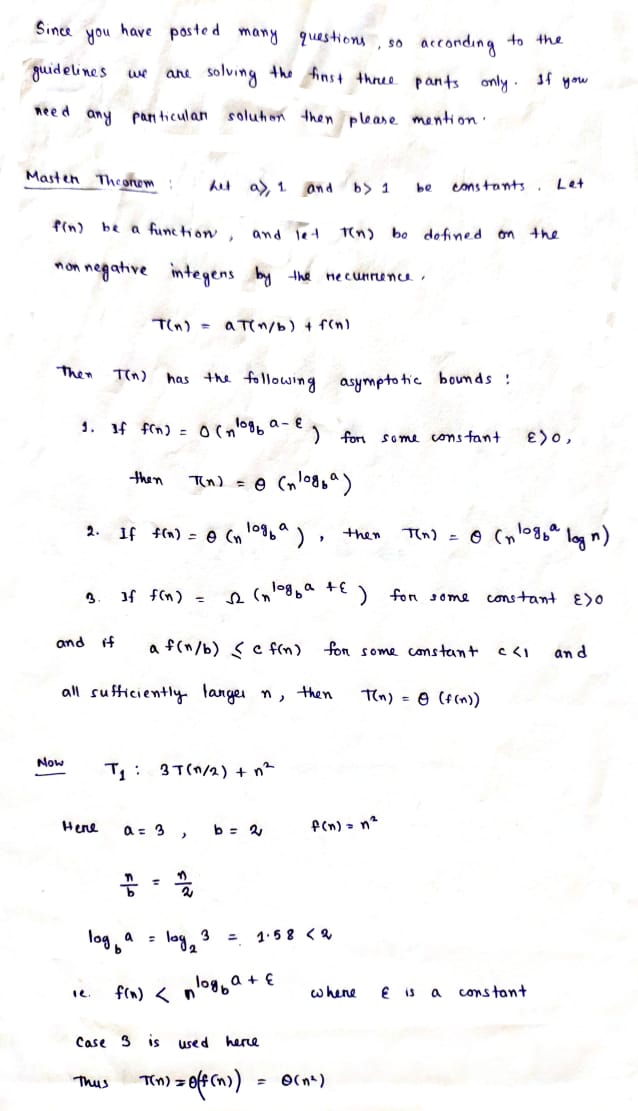P1.: (n)-37 (n/2) +n² 12: 7(n)=√√27 (n/2) +logn P3: I(n) = 3T (n/3) + n/2
Advanced Engineering Mathematics
10th Edition
ISBN:9780470458365
Author:Erwin Kreyszig
Publisher:Erwin Kreyszig
Chapter2: Second-order Linear Odes
Section: Chapter Questions
Problem 1RQ
Related questions
Question
I need help to solve problem with master method to determine the asymptotic complexity of closed formulas. The Master Method will be applicable to all four problems. For any problem that matches cases 1 or 3 of the Master Method, do not forget to show that function f(n) is also polynomially smaller (or, larger) than the corresponding log_b a^n .
![Certainly! Here's the transcription, suitable for an educational website:
---
### Recurrence Relations
The following are examples of common recurrence relations:
**P1:**
\[ T(n) = 3T(n/2) + n^2 \]
**P2:**
\[ T(n) = \sqrt{2} T(n/2) + \log n \]
**P3:**
\[ T(n) = 3T(n/3) + n/2 \]
**P4:**
\[ T(n) = 16T(n/4) + n! \]
**P5:**
\[ t_n = \begin{cases}
1 & \text{if } n = 0 \\
2 & \text{if } n = 1 \\
3t_{n-1} + 2t_{n-2} & \text{otherwise}
\end{cases} \]
#### Explanation of Recurrences
- **P1** is a recurrence involving a division of the problem size by 2 and multiplying the subproblem by 3, with an additional quadratic term.
- **P2** introduces a root factor and a logarithmic term to the recurring division by half of the problem size.
- **P3** divides the problem size by 3, multiplying the result by 3 and includes a linear fraction term.
- **P4** represents a significant increase in subproblem size with factorial complexity added.
- **P5** demonstrates a recursive sequence that involves simple base cases and a linear combination of preceding terms.
These recurrence relations are often solved using methods such as the Master Theorem, recursion trees, or the substitution method to derive their time complexities. They are frequently encountered in the analysis of algorithms, particularly those involving divide-and-conquer strategies.](/v2/_next/image?url=https%3A%2F%2Fcontent.bartleby.com%2Fqna-images%2Fquestion%2Ffbb9a233-ccbf-4977-a45b-ea6968028606%2Fb9f17e7d-f854-4d42-b7b9-f53e390fc5a0%2Fjr20528_processed.png&w=3840&q=75)
Transcribed Image Text:Certainly! Here's the transcription, suitable for an educational website:
---
### Recurrence Relations
The following are examples of common recurrence relations:
**P1:**
\[ T(n) = 3T(n/2) + n^2 \]
**P2:**
\[ T(n) = \sqrt{2} T(n/2) + \log n \]
**P3:**
\[ T(n) = 3T(n/3) + n/2 \]
**P4:**
\[ T(n) = 16T(n/4) + n! \]
**P5:**
\[ t_n = \begin{cases}
1 & \text{if } n = 0 \\
2 & \text{if } n = 1 \\
3t_{n-1} + 2t_{n-2} & \text{otherwise}
\end{cases} \]
#### Explanation of Recurrences
- **P1** is a recurrence involving a division of the problem size by 2 and multiplying the subproblem by 3, with an additional quadratic term.
- **P2** introduces a root factor and a logarithmic term to the recurring division by half of the problem size.
- **P3** divides the problem size by 3, multiplying the result by 3 and includes a linear fraction term.
- **P4** represents a significant increase in subproblem size with factorial complexity added.
- **P5** demonstrates a recursive sequence that involves simple base cases and a linear combination of preceding terms.
These recurrence relations are often solved using methods such as the Master Theorem, recursion trees, or the substitution method to derive their time complexities. They are frequently encountered in the analysis of algorithms, particularly those involving divide-and-conquer strategies.
Expert Solution
Step 1: Defining

Step by step
Solved in 3 steps with 5 images

Recommended textbooks for you

Advanced Engineering Mathematics
Advanced Math
ISBN:
9780470458365
Author:
Erwin Kreyszig
Publisher:
Wiley, John & Sons, Incorporated

Numerical Methods for Engineers
Advanced Math
ISBN:
9780073397924
Author:
Steven C. Chapra Dr., Raymond P. Canale
Publisher:
McGraw-Hill Education

Introductory Mathematics for Engineering Applicat…
Advanced Math
ISBN:
9781118141809
Author:
Nathan Klingbeil
Publisher:
WILEY

Advanced Engineering Mathematics
Advanced Math
ISBN:
9780470458365
Author:
Erwin Kreyszig
Publisher:
Wiley, John & Sons, Incorporated

Numerical Methods for Engineers
Advanced Math
ISBN:
9780073397924
Author:
Steven C. Chapra Dr., Raymond P. Canale
Publisher:
McGraw-Hill Education

Introductory Mathematics for Engineering Applicat…
Advanced Math
ISBN:
9781118141809
Author:
Nathan Klingbeil
Publisher:
WILEY

Mathematics For Machine Technology
Advanced Math
ISBN:
9781337798310
Author:
Peterson, John.
Publisher:
Cengage Learning,

